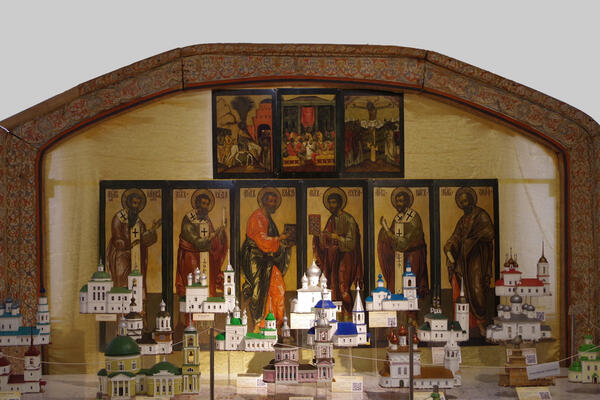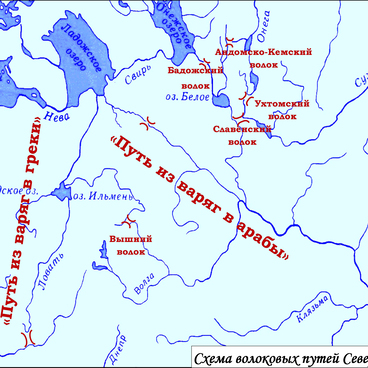The painted portal frame used to be in the wooden temple of Elijah the Prophet in the city of Belozersk. This temple was built in 1690-1696. Today it is the only surviving wooden temple of Belozersk, one of the seven remaining in Belozersk region. The church consists of two identical rectangular rooms of the temple and a refectory extending from west to east. The walls of the temple and the refectory are cut ‘v Oblo’ - this is the name of the technology when the logs crossed on the corner joints protrude.
A portal is an architecturally decorated entrance to the temple. This frame from the collection of the Belozersky Regional Museum decorated the entrance to the main hall of the temple on the side of the refectory.
The frame is covered with a skillfully executed mural in the form of a multicolored floral ornamental pattern of red, black and white colors inspired by folk patterns. The basis for painting is a wooden pine beam in the form of a deck consisting of 5 segments: two rectangular proper and three rectangular with a slight rounding at the edge. At the junctions of the segments of the block, the segments are locked. The segments are connected by means of internal grooves at the ends of the bar. The ends of the bar are decorated with a carved rake.
In the places where the portal frame was attached to the wall, special boards were installed - battens that were fastened to the portal with the aid of grooves or forged nails. The front of the napkins was also covered with pictorial ornament.
Such ornamental paintings are often found in the paintings of distaff, iconostasis beams such as shelf for icons, bast baskets, sleds and other works of folk art widely popular in the Russian North. The ornament serves as a versatile and significant artistic technique, has a rich colour scheme, rhymes with the elements of wooden architecture, serves as its decoration, and does not simply embody the personality of the master, but also expresses the specificity of a particular historical and cultural environment. Researchers suggest that this pattern was performed by more than one master, based on differences in the manner of execution and execution of ornamental forms.
A portal is an architecturally decorated entrance to the temple. This frame from the collection of the Belozersky Regional Museum decorated the entrance to the main hall of the temple on the side of the refectory.
The frame is covered with a skillfully executed mural in the form of a multicolored floral ornamental pattern of red, black and white colors inspired by folk patterns. The basis for painting is a wooden pine beam in the form of a deck consisting of 5 segments: two rectangular proper and three rectangular with a slight rounding at the edge. At the junctions of the segments of the block, the segments are locked. The segments are connected by means of internal grooves at the ends of the bar. The ends of the bar are decorated with a carved rake.
In the places where the portal frame was attached to the wall, special boards were installed - battens that were fastened to the portal with the aid of grooves or forged nails. The front of the napkins was also covered with pictorial ornament.
Such ornamental paintings are often found in the paintings of distaff, iconostasis beams such as shelf for icons, bast baskets, sleds and other works of folk art widely popular in the Russian North. The ornament serves as a versatile and significant artistic technique, has a rich colour scheme, rhymes with the elements of wooden architecture, serves as its decoration, and does not simply embody the personality of the master, but also expresses the specificity of a particular historical and cultural environment. Researchers suggest that this pattern was performed by more than one master, based on differences in the manner of execution and execution of ornamental forms.


